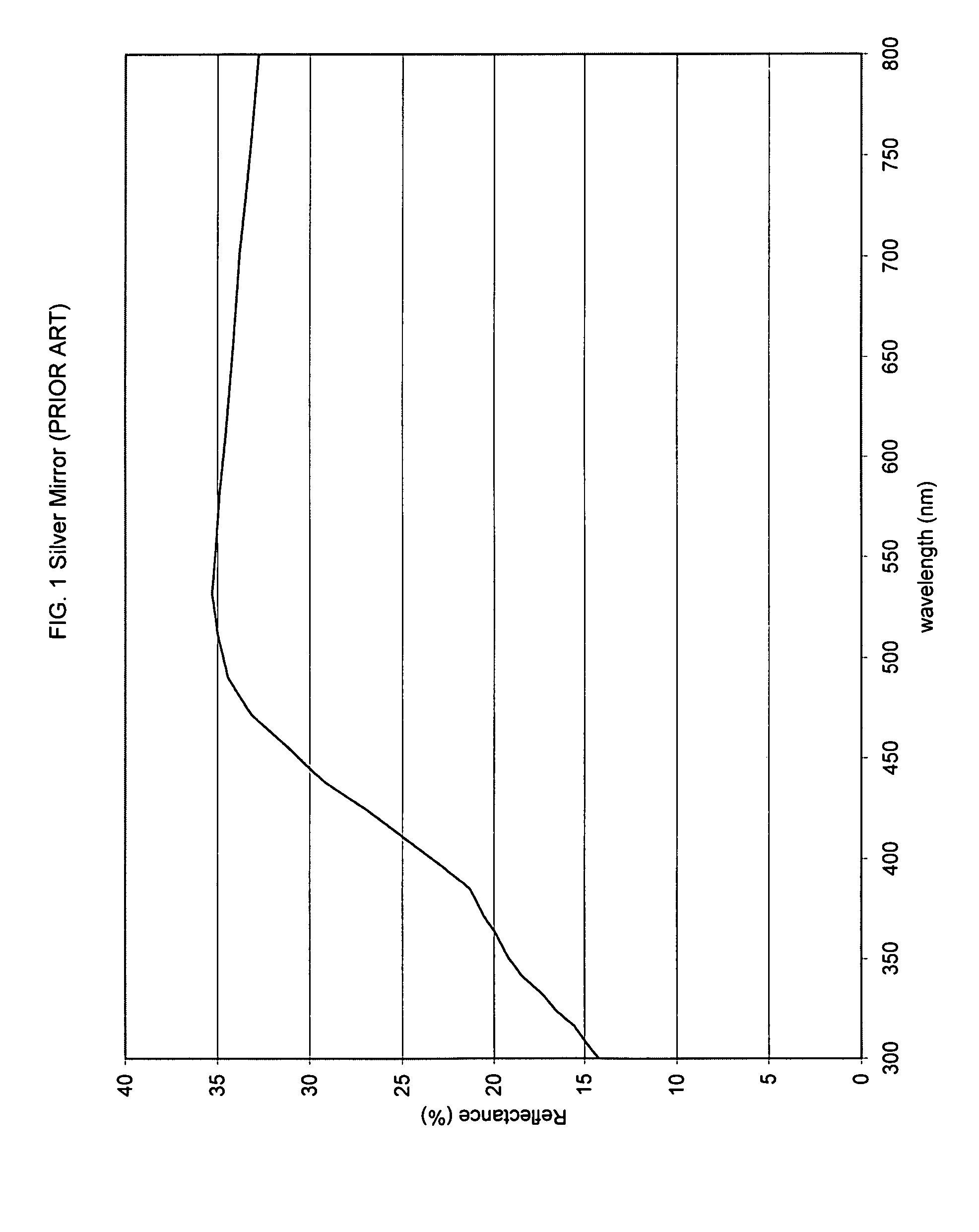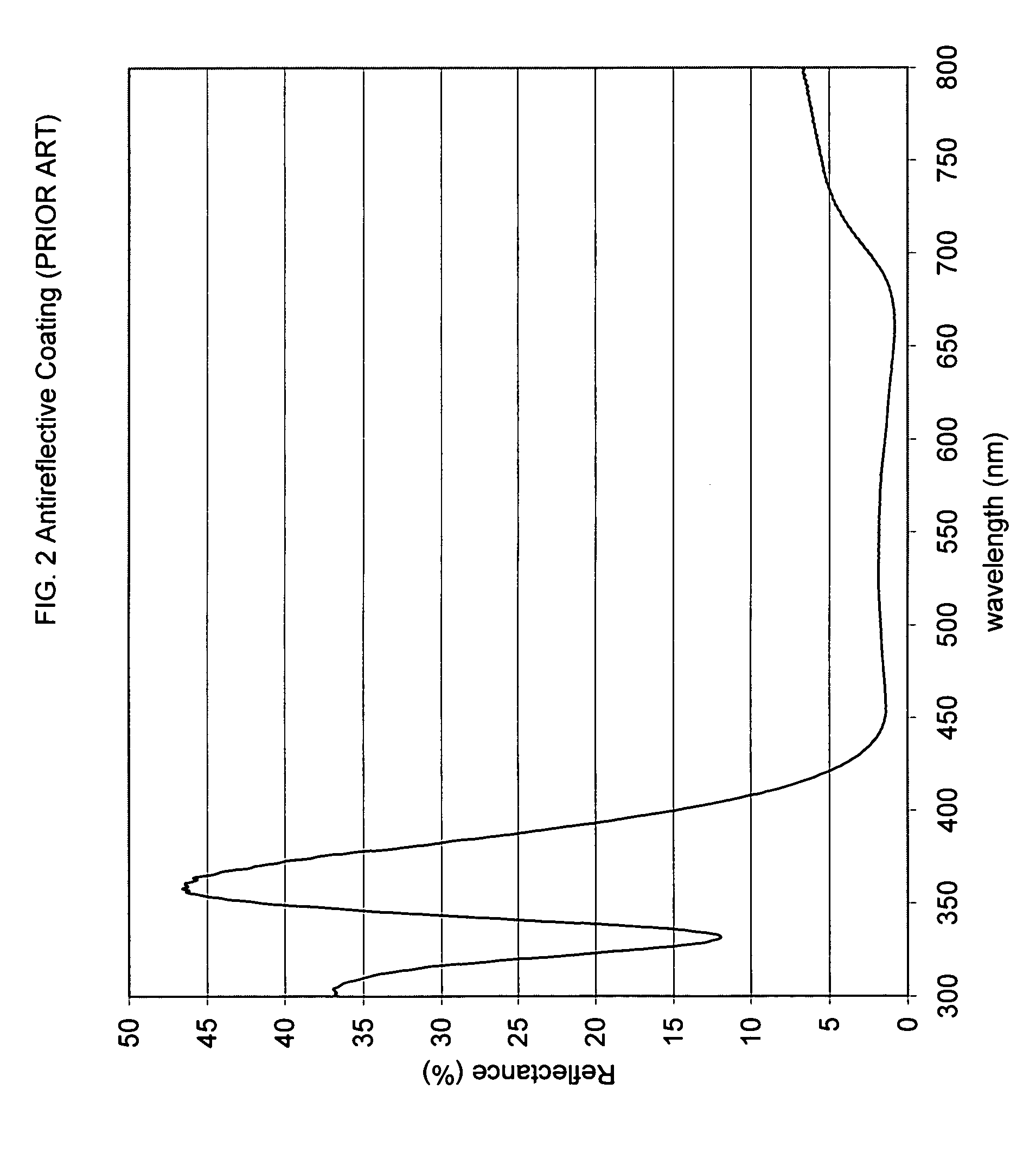Multilayer interference filter for photochromic lenses
a multi-layer interference and filter technology, applied in the field of optical quality, can solve the problems of significantly unable to meet the requirements of these treatments, and unable to achieve the effect of affecting the original photochromic activity of the lens
- Summary
- Abstract
- Description
- Claims
- Application Information
AI Technical Summary
Benefits of technology
Problems solved by technology
Method used
Image
Examples
example 1
The Silver Mirror effect is obtained by depositing the following 12 layers of SiO2 and TiO2 on an ADC lens:
[0033]
LayerMaterialThickness (nm)1TiO23.242SiO222.413TiO26.124SiO221.215TiO233.86SiO214.947TiO229.858SiO2102.429TiO224.6110SiO27.5311TiO29.1312SiO229.38Medium: Air
[0034]Table 2 below shows the activation % of Example 1 compared to the Activation of the same lens uncoated.
[0035]
TABLE 2PhotochromicUncoated lensExample 1lens typeActivation (%)Activation (%)ADC52%53%
[0036]FIG. 5 shows the reflectance curve of example 2, which is an ADC lens coated with a film having a UVA reflectance of less than 6% in the range from about 315 to 400 nm, in accordance with an embodiment of the present invention. The film provides the lens with the appearance substantially resembling the prior art “White Silver” decorative coating of FIG. 3.
example 2
[0037]The film, in accordance with an embodiment of the present invention, comprises the following 12 layers of TiO2, ZrO2 and SiO2 dielectrics deposited on an ADC lens:
[0038]
LayerMaterialThickness (nm)1TiO24.352SiO217.93TiO29.594SiO231.35ZrO222.66SiO229.77TiO233.058SiO2106.669TiO225.1510SiO222.9511ZrO210.2312SiO23.33Medium: Air
[0039]Table 3 below shows the activation % of Example 2 compared to the activation % of the same lens uncoated and the same lens coated with the prior art “White Silver” coating.
[0040]
TABLE 3LensLens coated withcoated withprior artPhotochromicUncoated lensExample 2“White Silver” coatinglens typeActivation (%)Activation (%)Activation (%)ADC52%52%7%
[0041]FIG. 6 shows the reflectnce curve of Example 3, which is an ADC lens coated With an antireflective coating with a reflectance less than 15% in the range of about 350 to 400 nm, in accordance with an embodiment of the present invention. Referring to FIG. 7, dielectric layers 20, 30, 40, 50 are deposited on a len...
example 3
[0042]The antireflective coating is obtained depositing four alternating layers of TiO2 and SiO2 dielectrics on an ADC lens in the following order:
[0043]
LayerMaterialThickness1TiO212.262SiO229.593TiO290.694SiO278.90Medium: Air
[0044]Table 4 below shows the Activation of Example 3 compared to the same lens uncoated. The results of Table 4 illustrate that Example 3 permits the lens to be coated with an antireflective coating without losing any photochromic activation.
[0045]
TABLE 4PhotochromicUncoated lensExample 3lensActivation (%)Activation (%)ADC52%52%
[0046]The previous examples disclose three different multilayer coatings, in accordance with the invention, for use with photochromic lenses which do not adversely affect their photochromatic activity. This result is obtainable by selecting and arranging each layer in order to maintain the Reflectance preferably under 15% and more preferably under 6% preferably in the range from about 315 to 400 nm and more preferably in the range from ...
PUM
| Property | Measurement | Unit |
|---|---|---|
| specific wavelengths | aaaaa | aaaaa |
| wavelengths | aaaaa | aaaaa |
| wavelengths | aaaaa | aaaaa |
Abstract
Description
Claims
Application Information
 Login to View More
Login to View More - R&D
- Intellectual Property
- Life Sciences
- Materials
- Tech Scout
- Unparalleled Data Quality
- Higher Quality Content
- 60% Fewer Hallucinations
Browse by: Latest US Patents, China's latest patents, Technical Efficacy Thesaurus, Application Domain, Technology Topic, Popular Technical Reports.
© 2025 PatSnap. All rights reserved.Legal|Privacy policy|Modern Slavery Act Transparency Statement|Sitemap|About US| Contact US: help@patsnap.com



